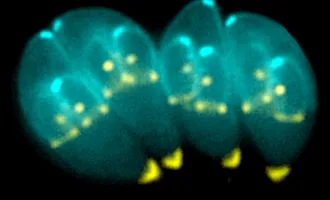
The Hilarious and Compelling Origins of the Pap Smear
Editor's note: Presenting Iva Petrovchich's winning entry in the 2018 Synapse Storytelling Contest's science writing category. Category judge, San Francisco Chronicle science writer Erin Allday, says, "Public Cervix Announcement had a fantastic lede – not just the opening sentence, but the opening paragraph. I was captivated from the start and the rest of the piece did not let me down. I enjoyed the easy, story-telling style. The writer did a good job of mixing science, historical context and fun anecdotes while keeping the piece moving forward at a good pace. At the end of the piece I found myself wanting to read even more about this topic."
It is safe to say that nobody’s favorite thing is having a pap smear. While it doesn’t make the speculum any warmer, the story behind this revolutionary cancer screening may be a welcome distraction and a very rag-tag perspective on scientific breakthrough. In the end, it is all thanks to a Greek immigrant couple, the unluckiest of guinea pigs, and insatiable curiosity that cervical cancer screening is routine and cervical cancer is largely preventable.
Meet Dr. Georgios Nikolaou Papanikolaou: born into a doctor-filled household in 1883. As all old-timey heroes seem to do, he bounced between wildly impressive beginnings: entering medical school in Athens at the age of 15, being an army surgeon in the Balkan wars, treating literal lepers in his hometown, and lending a hand in the Oceanographic Exploration Team of the Prince Albert I of Monaco. He followed his MD with a PhD in Zoology, and came to America in 1913. Neither he nor his wife spoke any English, and they had only slightly more cash than the amount required to enter the US.
This is where his exciting antics came to a sudden halt: our hero could not find work. He was a rug salesman. A clerk at a newspaper. A violinist in a Greek restaurant. Finally, he found himself a role studying the ovulatory cycle of guinea pigs at New York University’s Pathology Department and Cornell University Medical College’s Anatomy Department.
Armed with a pediatric nasal speculum, he discovered that ovulatory cycles could be timed by examining smears of guinea pig vaginal secretions in 1916. This extremely glamorous work was not received with fanfare (although it also indirectly contributed to the discovery of estrogen and progesterone). Critics happily pointed out that unlike guinea pigs, menstruation in humans is obvious. While Dr. Papanikolaou wanted to move his cycle studies onto human subjects, human subjects were not available to him. Except for one — Andromache Mavroyenous “Mary” Papanikolaou. As perhaps the world’s most patient wife, Mary endured 21 years of daily pap smears for love and science.
Much like in the uncomfortable guinea pigs, Dr. Papanikolaou observed that he could see temporal changes in discharge related to the reproductive cycle in his uncomfortable wife, too. In yet another act of spousal loyalty, Mary invited some of her friends to a party and ultimately to pap smears. Weeks after the sampling, one friend was diagnosed with cervical cancer. Lo and behold: the cancerous cells were visible on the slides. In his own words: “The first observation of cancer cells in the smear of the uterine cervix gave me one of the greatest thrills I ever experienced during my scientific career.”
While he first presented his ideas that uterine cancer could be diagnosed by vaginal smear in 1928, it took over a decade to validate and prove. His work culminated in publishing the landmark Diagnosis of Uterine Cancer by the Vaginal Smear in1943 with Dr. Herbert Traut. Their book described both the pathophysiology of the menstrual cycle, and how to classify normal and abnormal smears taken from the vagina and cervix under the microscope. It may as well have shaken the earth.
For some context: cervical cancer was the number one cancer killer of U.S. women in the early 1900’s. To introduce a test that identifies cervical cancer, precancerous dysplasia and other cytological diseases that is both easy to perform and inexpensive was a radical act. It spread quickly and widely, and is still considered the most successful screening test ever introduced for preventing serious malignancies by the American Cancer Society. Within a decade of its introduction, annual pap smears became the gold-standard and the cervical cancer rate in the U.S. was cut in half.
Dr. Papanikolaou is quoted as saying his “ideal in life was neither to become rich, nor to live happily, but to work, act, create and do something worthy of a man who is moral and strong.” This humble man, his heroic wife, and his long-suffering guinea pigs surely met that ideal, and contributed to a 70% reduction in cervical cancer mortality.



